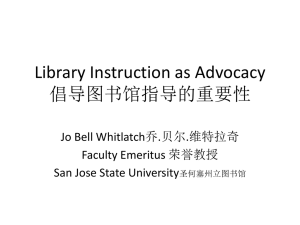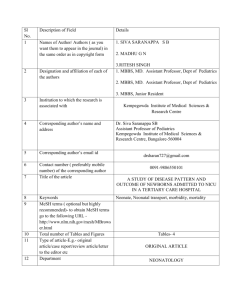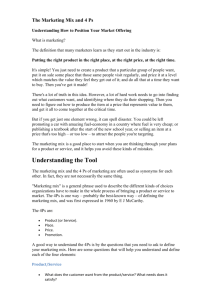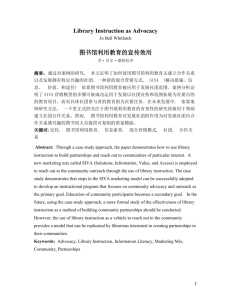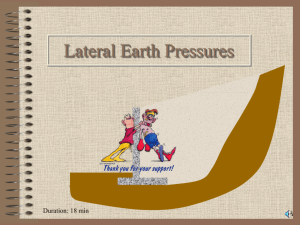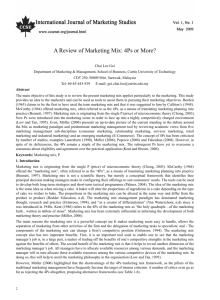The Marketing Mix Matrix
advertisement
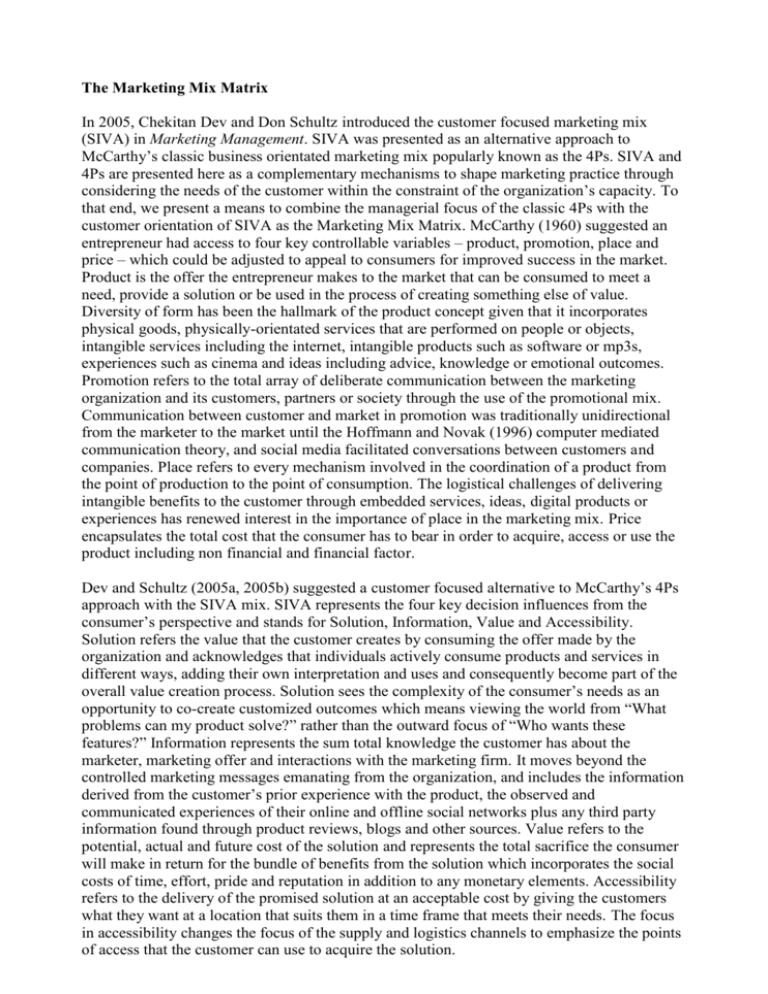
The Marketing Mix Matrix In 2005, Chekitan Dev and Don Schultz introduced the customer focused marketing mix (SIVA) in Marketing Management. SIVA was presented as an alternative approach to McCarthy’s classic business orientated marketing mix popularly known as the 4Ps. SIVA and 4Ps are presented here as a complementary mechanisms to shape marketing practice through considering the needs of the customer within the constraint of the organization’s capacity. To that end, we present a means to combine the managerial focus of the classic 4Ps with the customer orientation of SIVA as the Marketing Mix Matrix. McCarthy (1960) suggested an entrepreneur had access to four key controllable variables – product, promotion, place and price – which could be adjusted to appeal to consumers for improved success in the market. Product is the offer the entrepreneur makes to the market that can be consumed to meet a need, provide a solution or be used in the process of creating something else of value. Diversity of form has been the hallmark of the product concept given that it incorporates physical goods, physically-orientated services that are performed on people or objects, intangible services including the internet, intangible products such as software or mp3s, experiences such as cinema and ideas including advice, knowledge or emotional outcomes. Promotion refers to the total array of deliberate communication between the marketing organization and its customers, partners or society through the use of the promotional mix. Communication between customer and market in promotion was traditionally unidirectional from the marketer to the market until the Hoffmann and Novak (1996) computer mediated communication theory, and social media facilitated conversations between customers and companies. Place refers to every mechanism involved in the coordination of a product from the point of production to the point of consumption. The logistical challenges of delivering intangible benefits to the customer through embedded services, ideas, digital products or experiences has renewed interest in the importance of place in the marketing mix. Price encapsulates the total cost that the consumer has to bear in order to acquire, access or use the product including non financial and financial factor. Dev and Schultz (2005a, 2005b) suggested a customer focused alternative to McCarthy’s 4Ps approach with the SIVA mix. SIVA represents the four key decision influences from the consumer’s perspective and stands for Solution, Information, Value and Accessibility. Solution refers the value that the customer creates by consuming the offer made by the organization and acknowledges that individuals actively consume products and services in different ways, adding their own interpretation and uses and consequently become part of the overall value creation process. Solution sees the complexity of the consumer’s needs as an opportunity to co-create customized outcomes which means viewing the world from “What problems can my product solve?” rather than the outward focus of “Who wants these features?” Information represents the sum total knowledge the customer has about the marketer, marketing offer and interactions with the marketing firm. It moves beyond the controlled marketing messages emanating from the organization, and includes the information derived from the customer’s prior experience with the product, the observed and communicated experiences of their online and offline social networks plus any third party information found through product reviews, blogs and other sources. Value refers to the potential, actual and future cost of the solution and represents the total sacrifice the consumer will make in return for the bundle of benefits from the solution which incorporates the social costs of time, effort, pride and reputation in addition to any monetary elements. Accessibility refers to the delivery of the promised solution at an acceptable cost by giving the customers what they want at a location that suits them in a time frame that meets their needs. The focus in accessibility changes the focus of the supply and logistics channels to emphasize the points of access that the customer can use to acquire the solution. Marketing mix and SIVA centric approaches both have advantages and disadvantages when used in marketing practice. The marketing mix has been criticized for its organizational focus at the expense of the customer orientation. However, it needs to be recognized that the organizational focus is an integral feature of the marketing mix since the system was designed as the set of variables that an entrepreneur can manipulate. Given the marketing mix was production-dominated by design, Dev and Schultz were right to introduce a customer orientated mix. SIVA’s strength lies in its capacity to translate the needs of the market into actionable business behaviors for the entrepreneur to adopt, adapt and applied as necessary. That said, as a marketing function, SIVA is heavily customer-dominated by design, and lacks the command and control focal points of the previous marketing mix. The strengths of one framework are the weaknesses of the other, and as such, a combined approach of listening to the market and tailoring the controllable elements of the business framework to bring an idea to commercial reality in the marketplace. The Marketing Mix Matrix is designed to consolidate both the 4Ps and SIVA into an integrated business process framework by creating a 4x4 matrix of value offering decision making which blends each element of SIVA and the classic marketing mix to create an environment where an entrepreneur can assess their potential value offering to the marketing through the lens of producer and consumer.. Figure 1 outlines the Marketing Mix Matrix as a series of consumer focused questions for marketing managers to consider when adjusting the 4Ps marketing mix. Figure 1: The Marketing Mix Matrix Product Promotion Price Place Does the product Does the message What’s the value Where is the Solution help meet the help solve the of the price tag solution to be need or solve the problem? for the customer? found? problem? What’s the What can the What does where Information What does the product say about (official) word of customer learn you get the itself? mouth about the from the product say about company? product’s price? the product? How do the Is the message Is the product Does Value features lower raising the cost or worth it? convenience or costs or increase worth of the exclusivity make value? product? it worth more? Can the consumer Who’s telling the What’s it cost to Can the customer Access find the solution customer how get to the get the product embedded in the and where to get product? where they want product? the product? it? The application of the marketing mix matrix creates sixteen cells, each of which provide customer focused options for managerial action. Product*Solution: Does the product help meet the need or solve the problem? Solutions are created by the customer. Consequently, the role of the product is to facilitate a solution by having the necessary features required by the customer to address their needs. Co-creation of value is central to assisting solution provision. Customers need to have the freedom to use the product in the manner they desire, and not necessarily in the manner first envisioned by the marketer. Use innovation by customers creates entrepreneurial opportunity to produce minor tweaks to an existing offering to address a broader need. For example, 3M recognized the opportunity created by consumer use of masking tape for pet hair removal which was met by the creation of the 3M Pet Hair Roller product series. Product*Information: What does the product say about itself? Customers can learn more about a product from using it, watching it in action or experiencing a trial version for a limited time than simply being told about it. The Product-Information approach incorporates trial experience as self-sourced product recommendation system. Product test drives represent the practical application of product use as an information source for the physical world or virtual world. Toyota, for example, offers virtual test drives of their Yaris model including a video of the car in action, and a tourist guide of the test drive area. This gives a feel for the car in action, and the lifestyle choices that Toyota feels match their machine’s brand and style. Product*Value: How do the features lower costs or increase value? Product-value links the capacity of the offering to reduce a cost elsewhere in the consumer’s life by increasing the feature set of a product. The Nike iPod sports kit which adds a suite of benefits for training including automatically record management of training data via automated input from the Nike+ shoes, and audio encouragement through the iPod while you train increases the overall value of the product by providing time savings and productivity. Product*Access: Can the consumer find the solution embedded in the product? Access at the product level is a case of asking where the customer can find the solution within the product. It is a multi-faceted aspect which examines the design of the product against the needs of the target market, and whether the feature set aids or hinders access to the sought-after solution. VCRs have had the time shifting capacity of the TiVo embedded somewhere behind a wall of programming steps and instruction manuals that many found hard to access. In contrast, careful feature design of the TiVo increased the accessibility of the time shifting functions, and improved the overall value of the product as a TV watching solution. Promotion*Solution: Does the message help solve the problem? Branding and marketing communication messages are part and parcel of the extended product, and a key aspect in how the solution will address intangible factors of social prestige and the construction of the consumer’s self image. Brands form a part of the solution by creating a social message that can be adopted, adapted and displayed by the consumer. The iPod white-earplugs and Everlast shirts communicates the fashion orientation of the wearer, their commitment to their training, and the fact they can’t hear you over their own private soundtrack. Promotion*Information: What’s the (official) word of mouth about the company? Promotional activities by the marketer give the customer the official corporate message from the organization about their products. It forms a useful base line for the customer to use to compare with word of mouth information as means of crosschecking what the advertising promises and the product delivers. Customers can derive useful pre-purchase information from the style and content of the promotional activity of the firm. The content, execution and application of promotional materials will influence how people feel about the organization, and will give them an additional source of information to use in purchase decisions. Promotion*Value: Is the message raising the cost or worth of the product? Promotion is designed to portray the benefits to be gained from the product, and how these benefits will outweigh the costs of purchase and use. The total value of the product is also dependent on the associated value of the product’s brand, and the parent company’s reputation. For example, Sony’s involvement in a range of perceived anti-customer activities such as supporting the RIAA’s lawsuits against music consumers, plus their use of illegal technology in copyright protection will have an impact on the value of the Sony brand as a social status symbol amongst technology users. Promotion*Access: Who’s telling the customer how and where to get the product? Promotion and access combine to inform the customer as to where the solution can be found by identifying retail outlets, distribution channels or websites. Where a product relies on use rather than ownership for the solution, the promotional messages can play an educational and training role to show where the solution can be accessed within the product. Alternatively, the promotion messages can direct the consumer to specific outlets, as ABC does with the Grey’s Anatomy website, by offering customers the choice of television schedule times, a link to the iTunes download page or a link to purchase a DVD. Price*Solution: What’s the value of the price tag for the customer? Financial price-solutions create benefit from prestige pricing and the social messages associated with the purchase and ownership of luxury products. Part of the appeal of the top level Louis Vuitton designer products is the widely known price tag that conveys the social status of having enough cash to buy the purse and still have something to put into it afterwards. At the other end of the spectrum, price can be used to provide the necessary benefit set that meets the needs of the customer by being cheaper, more economical or providing better financial return. Nonfinancial pricing ties into the problem-solving aspect of solution as the product can be feature set to reduce a non-financial cost of time, effort, or complexity. Netflix utilizes the nonfinancial price aspects of conveniences and ease of use as part of their pricing strategy for rentals and provide the solution of no-late fees as a bonus financial incentive. Price*Information: What can the customer learn from the product’s price? Price is a means for a consumer to measure the worth of a product, and as such, the price helps inform the purchase decision from the extreme of if you have to ask, you can’t afford it through to assessing the affordability of the solution. Price is a determining factor in the purchase decision as affordability also incorporates known associated on-costs such as subscription fees or, as is the case with IKEA furniture, the knowledge that a new set of shelves will inevitably lead to refitting the entire room with updated furniture. Price is a mechanism to also communicate the networth of the individual consumer to their friends where brands are known, and the cash price of the brand is as much of a bragging point as the quality of the merchandise. Price*Value: Is the product worth it? Price-Value is the customer generated opinion of what to pay for a given product or service, and whether the price being charged meets the desired price the customer had in mind for the product. Negotiable pricing strategies are available for matching the customer’s view of the value of a service with the price they’re willing to pay through auctions, tipping and barter systems. Services marketers have long used the reverse mechanism of setting the price at a level to imply the value of the service just received – particularly if the customer is unlikely to be competent to objectively critique the medical, legal or financial planner’s skills. Service entrepreneurs can communicate the worth of an idea (the new product concept) with the price schematics (free to try, freemium for greater options, fee based for full experience) Price*Access: What does it cost to get to the product? The price of a product will dictate how accessible it is to a market, and, even if it is an optimum solution to their problem, whether it will be adopted or if a cheaper alternative will win out. Access prices incorporate the costs associated with the logistics of shipping products, the inconvenience of delays between ordering and consumption of a product, and the total costs associated with receiving the benefit embedded somewhere in a service, good or experience. Place*Solution: Where is the solution to be found? Distribution is the mission critical element in the total value of a solution. No matter how useful the product appears in the promotion, and how much the word of mouth endorses it, the proof of the product is in the ownership and use. If the distribution network cannot deliver a product to the customer, it cannot be considered to be a solution to the customer’s needs. It also determines if the value of the services is location dependent or can move to the customer. This is a significant aspect for entrepreneurship based on a regionalized product (either sourced locally, or with limited shipping capacity) who may draw the attention of a global market that they can’t service. Place*Information: What does where you get the product say about the product? Retailers have long pioneered the use of the retail channel as a means of conveying a message about the product. Personal selling at the point of sale provides an official, or third party endorsed, word of mouth recommendation right at the critical sales moment. Store brands convey their own messages to the customer regarding the products found inside - shopping at Wal*Mart, Best Buy or the Apple Store conveys a different set of expectations of the products. Place and information allow for in-store displays, point of purchase promotions, and the in-store trials of the product in a safe environment for the customer (and the product) where help, explanations and assistance are a sales clerk away. Place*Value: Does convenience or exclusivity make the product worth more? Part of the information provided by the distribution channel relates to the exclusivity and desirability of a product. The value of a luxury good is based on the extent to which it offsets the consumer from the rest of the field. This is determined in part by price and part by access to the product. Paradoxically, exclusivity can increase the perceived value and benefit of the product by increasing the difficulty of acquisition, and the subsequent reward for success – witness the demand for the exclusively distributed iPhone and the sense of consumer pride in acquiring the product on launch day. Place*Access: Can the customer get the product where they want it? Place –Access is the question of whether the customer can get to the solution they want, when they want it, and in a manner that the organization can deliver without compromising the value or solution. Given the first question asked in the marketing mix matrix is Does the product help meet the need? the answer will always be no if the distribution network can’t provide access to that product. Customer co-creation of value makes it clear that the value from a solution will occur where the customer is – it’s just a question of whether the organization is present at the time, or the customer is somewhere else with the product. Either way, the access to the product is the critical point where the solution has to be delivered either directly to the customer, or embedded into a physical good for later use by the customer. Marketers familiar with either version of the marketing mix can make use of the Marketing Mix Matrix to supplement and support their marketing activities by combining the elements that they can control (4Ps) with realistic assessments of the marketplace (SIVA). The approach also returns the marketing mix and SIVA to their origins as holistic systems with interconnected elements rather than isolated silos of activity. In working through the Mix Matrix, the marketer has the opportunity to consider how different elements of the 4Ps can inform the customer, create or lower access barriers, provide value and contribute to the total solution. Although Dev and Schultz proposed a changing of the guard in 2005, we now propose that customer orientation and managerial control be combined to strengthen the operation of marketing as the means to satisfying customer needs and organizational objectives for the benefit of marketer and marketplace alike. References Dev, S and Schultz, D 2005a) A customer-focused approach can bring the current marketing mix into the 21st century”, Marketing Management, 14(1) 16-22 Dev, S and Schultz, D 2005b) “Simply Siva”, Marketing Management, 14(2) 36-42 Hoffman, D. and Novak, T. 1996, “Marketing in hypermedia computer mediated environments: conceptual foundations”, Journal of Marketing, Vol.60, July, pp.50-68. McCarthy, E. J. 1960, Basic Marketing, A Managerial Approach. Homewood, IL: Richard D. Irwin.
